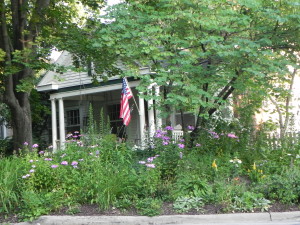Worldwide concern over dramatic declines in honeybee populations the past few years have hit the news. These intriguing and highly beneficial insects pollinate thousands of species of flowers, but media reports lead us to believe that they are the only pollinator and the disappearance of honeybees will leave plants unable to pollinate. The result will decimate human food supplies.
That’s only true in context. Honeybees are Old World natives introduced to North America in early settlement days. Before Columbus there were no honeybees on the continent, but obviously plants pollinated, thanks to dozens of other insect species as well as a few mammals.
Honeybee loss is of huge concern to anyone who likes to eat because of the way our society farms. Immense monoculture orchards and fields lack habitat for native pollinators. Farmland is often doused with insecticides. Farmers place honeybee colonies in the midst of vast almond and fruit orchards as well as other crops to pollinate these giant biological deserts that can’t support other pollinator species.
Fortunately, there are ways homeowners can welcome pollinators to their yards.
Become a beekeeper. It’s a fascinating hobby that yields satisfaction, pollination and delicious honey. Learning beekeeping takes effort and may not be legal in some cities. Look for future Winding Pathways blogs on beekeeping or contact your local extension agent or nature center to learn about beekeeping classes and locate experienced beekeepers. Beekeepers are usually eager to mentor newcomers.
Create pollinator homes. Mason bees are efficient, fascinating pollinators that are easy to attract to yards. While they do not yield honey they do get the pollination job done. Mason bees lay eggs in cavities in wood and readily use nesting structures placed in a yard. Most garden supply companies sell mason bee “houses” made of many tubes joined together. A mason bee home can be easily made from scrap wood. We made ours from several pieces of scrap 2X6 lumber screwed together to form a thick short piece of artificial tree. We drilled holes in it for the bees to raise their larvae, painted it and hung it from our deck. A few bees used it the first season with more moving in the next year. Google “Mason Bee” and choose from the many plans.
Create a pollination pocket, or PP, in the yard. Many pollinators only need a small patch of tall vegetation to hide in and raise their young. Mowed and sprayed lawns lack pollinator habitat. Often vast subdivisions are so manicured that hardly a beneficial insect can live there. So, to create the simplest PP just stop mowing a strip of lawn and let grasses and weeds grow tall there. The bigger the patch the better but even a 10 or 20 foot long and two foot wide strip will house pollinators.
The downside of letting a patch of lawn grow up is that plant species diversity will be limited and problem weeds may grow. Pollinators love weeds, but neighbors don’t. Be creative. The greater the diversity of flowers the more colorful the PP will be, the more beneficial insects it will attract and the more neighbors will like it. Our PPs include a wide variety of native grasses and wildflowers. Because we live in Iowa many of our plants are native prairie species but we also encourage some ornamental exotic flowers. One of our favorites is the cupplant. It’s tall and gangly but dozens of insect species love it. So do goldfinches and hummingbirds! On most sunny summer days tiger swallowtail butterflies and bumblebees visit it. Goldenrods and milkweeds are also outstanding pollinator plants.
A PP can serve many purposes. Tall, colorful patches of flowers and grasses can form walkway boundaries – winding pathways – in the yard and also can put steep or rough hard to mow areas to good use. A PP does more. The plants sink roots deep into the earth holding soil and creating space for rainwater thus reducing runoff. For a tranquil evening activity, sit quietly near a pollination pocket with a pair of binoculars that will focus closely and enjoy the constant coming sand goings of dozens of species of intriguing insects.
Take a step in creating a wondrous yard by creating a pollinator pocket. It will add summer color to the yard and invite all sorts of delightful and helpful insects to cohabit your space.


